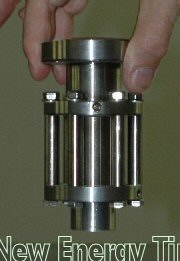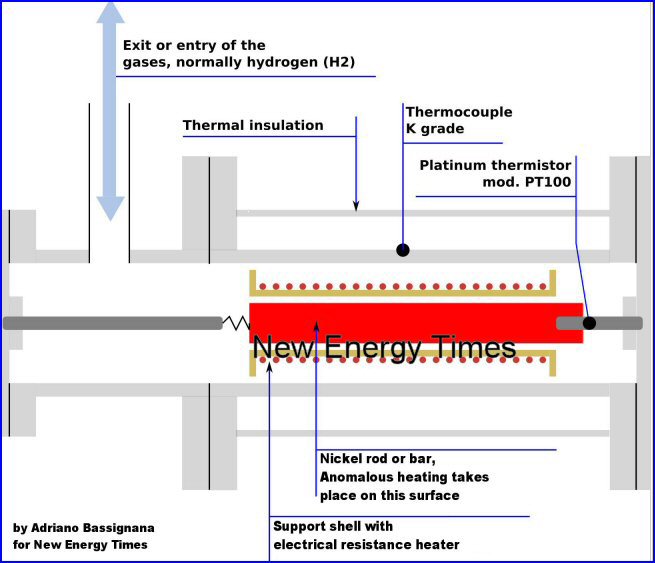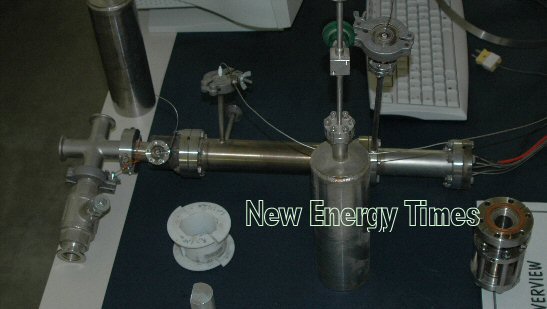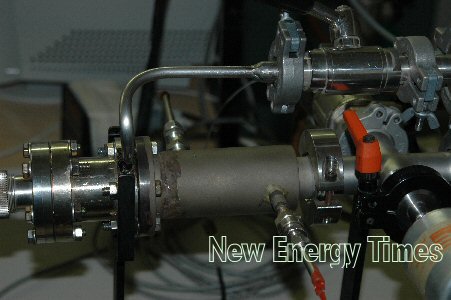Piantelli-Focardi Publication and Replication Path
By Steven B. Krivit
After Francesco Piantelli discovered excess heat in a nickel-hydrogen system on Aug. 16, 1989, and after his rage about his destroyed experiment subsided, he regrouped and gave it another try.
In February 1990, he saw the heating anomaly for the second time. But this time, he controlled the input power carefully and avoided getting into the higher temperature realm that would compromise the integrity of the cell. After a few cycles of loading the hydrogen gas into the cell containing the nickel sample, he decreased the power, and he saw the temperature rise. The pressure stayed constant. This confirmed to him that he was onto something real, anomalous and, more important, significant.
As we wrote in the previous article, throughout most of the 19-year history of the cold fusion controversy, most researchers in the condensed matter nuclear science (CMNS) field held the opinion that LENR reactions required palladium, an expensive precious metal, and deuterium, a form of hydrogen that exists naturally at a ratio of one deuterium for every 6,000 atoms of normal hydrogen in water. The information contained within this report and other scientific research in the public domain suggests that possible future technological applications of this research will not be bound to the use of palladium, but may instead require the relatively inexpensive metal nickel.
 1992 Piantelli-Focardi Ni-H Cell Photo: S.B. Krivit |
The Piantelli-Focardi group wrote an outstanding chronology of the history of the related experiments on Page 2 of “Overview of H-Ni Systems: Old Experiments and New Setup.”[19]
However, the researchers’ seminal paper is “Anomalous Heat Production in Ni-H Systems,”[3] published in the Italian Physics Society’s Il Nuovo Cimento in 1994. They reported an experiment performed at the University of Siena beginning in October 1993 that produced “50 Watts of anomalous heat production in a hydrogen-loaded nickel rod” with a “mean power imbalance of 44 Watts for a period of 24 days, corresponding to 90 MJ.” Dieter Britz, a longtime independent observer of LENR research, summarized the paper: “A Ni rod, 5 mm diameter and 90 mm long, was placed in a cylindrical chamber, surrounded by a Pt heater coil. The chamber could be evacuated or filled with gas (H2 or D2) at various pressures. The system was checked by replacing the Ni rod with a stainless steel one, and its temperature was noted as a function of heater power applied and gas pressure. With the Ni rod, the best temperature for H2 absorption was found to be 173C. Some Ni rods showed the expected temperature as a function of heater power in a H2 atmosphere, and others had elevated temperatures, showing that there was excess heat, on the order of 20-50 Watts, with heater power at 40-120 Watts.” |

Conceptual diagram of Piantelli-Focardi-type Ni-H Cell

Engineering drawing of Piantelli-Focardi-type Ni-H Cell (Click for larger image)

1992 Piantelli-Focardi Ni-H Cell (It’s the long horizontal object lying on table)
Photo: S.B. Krivit
In the authors’ own words, “the gas absorption was accompanied by a strong rise of the rod temperature standing high for such a long time [so as] to render the heat production involved incompatible with any classical theory.”
The authors also reported that they attempted but failed to detect neutrons and gamma rays above background during the process. This paper cites only one reference: the preliminary note [1] of Martin Fleischmann, B. Stanley Pons and Marvin Hawkins.
After the Piantelli-Focardi researchers’ paper published, they held a press conference which was covered by Foresta Martin Franco of Corriere Della Sera in Milano, Italy.[4] The news report, and the press conference, convened by local politician Luigi Berlinguer, occurred on Feb. 19, 1994.
“The research,” the paper quoted Berlinguer as saying, “even though underfunded, can produce great results.” (“La ricerca, anche se sostenuta da mezzi poveri, può produrre grandi risultati.”)
Failure to Replicate at CERN
The next publishing milestone is the report of the attempt by researchers at CERN, the European center for high energy physics research, to replicate the Piantelli-Focardi group’s work. The CERN group’s report published in December 1996 in Il Nuovo Cimento [9]. It is a peculiar report.
The authors state, “We have found the [Piantelli-Focardi group’s] results to be consistent with our observations; namely we measured higher temperatures for the same input power when hydrogen is absorbed during a heating cycle. Nevertheless this temperature rise does not appear to correspond to an increase in heat production. We have added a temperature sensor to the container of the experiment.
“The temperature of the container follows the same temperature with input power curve irrespective of whether there is an anomalous absorption of hydrogen or not; therefore we have no evidence that this temperature increase corresponds to another source of heat. In conclusion, we have observed all the effects discovered by Focardi et al., but our results imply that there is no production of power associated with the absorption of hydrogen by nickel.”
It is most peculiar. They see heat, as did the Piantelli-Focardi group, but their interpretation is that it is not anomalous.
Another interesting thing about the CERN paper is that, despite the fact that the Piantelli-Focardi researchers make no claim for fusion in their paper, aside from the journal’s classification of the paper, the CERN authors critique this nonexistent claim – in other words, introducing a “straw man” argument. The only related statement the Piantelli-Focardi group makes is that “work is now in progress to verify as a possible candidate for the heat generation the reaction (p, D), where D is that naturally contained in hydrogen.” No mention of fusion, no mention of any reaction chain.
However, the CERN authors lead off their article making a theoretical argument against the Piantelli-Focardi group’s paper, implying that the Piantelli-Focardi group is making a claim of fusion. The CERN group introduce the reaction pD > 3H3 + gamma and present the improbabilities of such as a critique to the Piantelli-Focardi group. The Piantelli-Focardi researchers also say nothing in their paper about helium, and what they say about gamma is that they failed to detect any above background.
The CERN group concludes its first section discouragingly: “Thus, the reaction pD appears to be an unlikely candidate.”
The CERN paper’s opening argument was disingenuous for the reason described above, as well as because the authors’ attempt to use known theory to discredit the Piantelli-Focardi group’s empirical work was unscientific.
The CERN authors admit that they lack information from the Piantelli-Focardi group’s paper. Perhaps these were essential details responsible for the failure to replicate.
They state that the Piantelli-Focardi researchers “do not specify exactly what they consider a loading cycle” – that is, CERN states, “On some occasions we observed absorption of hydrogen: The gas pressure started to decrease while the temperature of both the coil and the rod increased.”
Piantelli understands this process of loading clearly. He said, at least in the years following, that the process of loading the hydrogen properly into the nickel to attain a steady pressure is a prerequisite to seeing anomalous heat.
Later in the CERN authors’ paper, they state, “We found that this phenomenon of absorption of hydrogen was not reproducible.”
This is important. Without the proper hydrogen absorption into the nickel, excess heat almost certainly will not occur. This is exactly what Michael McKubre, director of energy research at SRI International, has said for many years about the D/Pd system: If you do not achieve the minimum loading threshold, you almost never see excess heat. But the language in the CERN statement has a political edge: The statement does not say the phenomenon was irreproducible in the group’s work; it says that the phenomenon was irreproducible, period.
Finally, the CERN authors write that they tried a 50/50 mix of hydrogen and deuterium and that, as well, failed to produce the claimed result. As Piantelli explains in “Deuterium and Palladium Not Required,” he now knows very well that the introduction of deuterium will kill any chances of a positive result.
This work, although it entails a significant effort, does not represent an effective critique of the Piantelli-Focardi group’s work, though it does provide useful information about an experiment that fails to replicate that work.
Piantelli-Focardi Group Responds to CERN
In November 1998, the Piantelli-Focardi group published “Large Excess Heat Production in Ni-H Systems,”[14] again in Il Nuovo Cimento. The paper directly responds to the most significant criticism of the 1996 CERN paper.
In the Piantelli-Focardi authors’ introduction to their new paper, they state that they modified the cell they reported in 1994 [3] with “an improvement which allows the measurement and the monitoring of the external surface temperature.”
“With this new set-up,” the Piantelli-Focardi group writes, “the external temperature increase, together with the internal one, have been utilized to characterize the excited state of the Ni sample. The existence of an exothermic effect, whose heat yield is well above that of any known chemical reaction, has been unambiguously confirmed by evaluating the thermal flux coming from the cells.”
The paper clarifies the term “excited state” as the phase in which the experiment was producing anomalous heat.
Britz wrote the follow summary of the 1998 Piantelli-Focardi group’s paper: “In addition to a cell used by this team earlier, consisting of a tubular vacuum chamber with a heating mantle around a Ni rod and a single temperature probe on the outside and the inside of the mantle, a new cell has now been designed with multiple probes.
“Hydrogen gas was admitted to the chambers, which were heated, and temperatures measured. Transient lowering of the input power produced, upon restoring the power, temperatures higher than before the transients. This showed the presence of nuclear phenomena, and calibrations performed calculated roughly 20 Watts of excess power generated by the hydrided Ni rods. The effect, once started, lasted for 278 days, the duration of the experiment.”

2007 Piantelli-Focardi Ni-H Cell
Photo: S.B. Krivit
In their 1994 paper, the Piantelli-Focardi researchers report that they saw no neutrons or gamma rays, though they later reported morphological changes in the nickel rods.[20] In the introduction of their 1998 paper, they report “very clear evidence of neutrons and gamma rays,” though these had been reported several years earlier, in 1995 [7], 1996 [8] and 1997 [13] in conference proceedings.
The next major paper from the Piantelli-Focardi researchers was published in September 1999 [16], again in Il Nuovo Cimento. One of their colleagues, Adriano Battaglia, had died, and they dedicated the paper to his memory.
“In this paper,” the authors write, “evidence is reported for neutron emission during energy production in Ni-H systems at about 700 Kelvin. Neutrons were detected directly by 3He counters and indirectly by gold activation.”
The paper goes into great detail about the arrangement and preparation of the three separate, independently powered neutron detectors and their careful efforts to isolate background cosmic-ray emissions. They report a temporal correlation of the neutron measurements along with the excess heat measurements.
“Two methods were used for neutron detection: direct counting by means of neutron detectors,” the authors write, “and counting of gamma rays emitted by neutron activated gold.”
The authors report a brief period of significant neutron activity above background that occurred during a heat excursion so strong that they had to drop the input power to the system several times in order to keep the system stable.
|
“Several input power reductions were needed to keep the |
“Such large deviations from the mean value,” the authors write, “occurred during a brief period for which the power emitted from the cell ‘A’ had a spontaneous increase (on the order of 10 Watts), and several input power reductions were needed to keep the working point temperature as constant as possible.”
The authors explained the logic behind their secondary neutron detection approach.
“A few elements,” the authors write, “as is well-known, have a high thermal cross-section for neutron capture. Among these, gold also has the characteristic of having some resonance peaks at energies higher than the thermal one. 197Au transmutes into 198Au by the reaction 197Au(n, gamma) 198Au. The latter decays with a 2.7-day half-life according to the process
![]()
in the 198Hg (411.8) level with a 99 percent branching ratio. The 198Hg decays to the ground state by emission of a 411.8 keV gamma-ray.”
The evidence for their hoped-for gamma ray peak is shown below.

“Gamma-ray spectra in the 350-500 keV region obtained with a germanium detector for: (a) gold sheet after the activation for 12 days on cell A; (b) gold sheet after the same exposition time to cosmic rays 10 m away from the cell; (c) gold sheet before the activation on the cell; (d) laboratory background.” [16, 19]
The paper reports a few other inexplicable anomalies and concludes that the data fall outside of current knowledge of nuclear physics.
University of Pavia: Failure to Replicate or Positive Confirmation?
One inexplicable part of the Piantelli-Focardi group’s history is the statement made by Adalberto Piazzoli of the physics department at the University of Pavia. Piazzoli also is vice president of CICAP (Italian Committee for the Control of the Affirmations on the Paranormale). He refers to an alleged failed replication attempt by Luigi Nosenzo (University of Pavia) and Luigi Cattaneo of Consiglio Nazionale Ricerche (National Research Council.)
“Unfortunately, we have not been able to reproduce some of the results of the cited colleagues,” Piazzoli writes, “but we know that, in the study of unknown phenomena, even though existing, the confirmations and refutation do not have the same verification value. Our esteem for our colleagues of Florence and Siena remains naturally unchanged.”
Piazzoli’s comments appear in the March/April 2008 issue of Scienza & Paranormale, and although he shows honor and respect for the researchers, there are two discrepancies. This first is in his language, which translates to “refutation.” He writes that confirmations and refutations do not have the same verification value.
Yes, there is some truth to this, but he seems to have used the wrong term. The term should be “failure to replicate,” not refutation.
The second anomaly is the display in Piantellil’s laboratory of the poster and data which discuss a nickel-hydrogen gas replication experiment performed at the University of Pavia. One of the graphs representing this data is in the “Deuterium and Palladium Not Required” article.
Other Evidence
As mentioned earlier, the paper “Overview of H-Ni Systems: Old Experiments and New Setup” is an excellent source of information and perhaps an ideal starting point to learn more about this group’s work. The paper also estimates the neutron flux, noted above, at a rate of 6,000 neutrons per second and shows the expected Compton peak. The Compton peak is famous among “cold fusion” skeptics for its absence from gamma-ray data in the March 1989 Fleischmann-Pons paper submitted to but rejected by Nature.
The Piantelli-Focardi group’s paper “Surface Analysis of Hydrogen Loaded Nickel Alloys” [20] reports SEM analysis which provides evidence for low-energy nuclear transmutation, and the group’s paper “Evidence of Electromagnetic Radiation from Ni-H Systems” [21] presents evidence for photon emission. Many other Piantelli-Focardi group papers from conference proceedings are available; some of them are listed in the reference section.[10, 12, 17,18] Piantelli also provided New Energy Times with an set of miscellaneous graphs and images. They are available here.
An interesting point in the related work is the common absence of excess heat when tritium is detected. [2,5,6,11] This same relationship with the D/Pd systems has been observed and reported by several researchers, specifically by McKubre in several conferences last year. It also will be published in a report from his group in the forthcoming American Chemical Society book “Low-Energy Nuclear Reactions Sourcebook,” edited by Jan Marwan and Steven B. Krivit. [22]
A related paper by Giuliano Mengoli et al., “Anomalous Heat Effects Correlated With Electrochemical Hydriding of Nickel,” was published in Il Nuovo Cimento in March 1998.[15]
Britz wrote the following comments to summarize the paper: “This is a confirmation of [LENR] in the Ni/light water system, but the Mills theory is rejected (a good brief history is provided). The authors note that this system shows better reproducibility than Fleischmann-Pons-type heavy water systems, but the Mills’ theory is refuted by experiments of Piantelli. …
“Both isothermal and non-isothermal calorimetry was used, at three working bath temperatures: 50C, 80C and 99C. Significant (up to 20-30 sigma) excess heat was found, increasing with temperature; but no blank controls were possible. Some (a few) runs failed, producing no excess heat in these; the cathodes were preoxidised, or organic impurities had been in these cells. Thus, surface treatment is important. There was a marked aftereffect – that is, excess heat after current cut-off.”
Mengoli et al. wrote, “We believe that the findings of both Mills and Piantelli have a common origin: In other words, the thermal effects observed in either electrolytic or dry environments start from the same physical-chemical state of the system. Although this is far from being an explanation of the phenomenon, elucidation of the physical-chemical conditions suitable for its induction is the first step in understanding it.”
References
- Fleischmann, M., et al., “Electrochemically Induced Nuclear Fusion of Deuterium,” Journal of Electroanalytical Chemistry, Vol. 261, Issue 2, Part 1, p. 301-308 (April 10, 1989) and errata in Vol. 263, p. 187-188, (1989)
- Srinivasan, M., et al., “Tritium and Excess Heat Generation During Electrolysis of Aqueous Solutions of Alkali Salts With Nickel Cathode,” Proceedings of the Third International Conference on Cold Fusion, Nagoya, Japan, Universal Academy Press Inc., Tokyo, Japan, (1992) [Ed: Srinivasan states that he has since withdrawn the excess heat part of the results because he found later that recombination does take place within an open cell, which could account for the excess heat.]
- Focardi S., Habel R., and Piantelli F., “Anomalous Heat Production in Ni-H Systems,” Nuovo Cimento, Vol. 107A, p. 163-167, (1994)
- Franco, Foresta Martin, “Siena scopre l’ energia pulita Fusione fredda all’ italiana?,” Corriere Della Sera, (Feb. 19, 1994)
- Notoya, R. et al., “Tritium Generation and Large Excess Heat Evolution by Electrolysis in Light and Heavy Water-Potassium Carbonate Solutions With Nickel Electrodes,” Fusion Technology, Vol. 26, p. 179, (Sept. 1994)
- Sankaranarayanan, T.K., Srinivasan, M., Bajpai, M.B., and Gupta, D.S., “Evidence for Tritium Generation in Self-Heated Nickel Wires Subjected to Hydrogen Gas Absorption/Desorption Cycles,” Proceedings of Fifth International Conference on Cold Fusion, Monte-Carlo, Monaco: IMRA Europe, Sophia Antipolis Cedex, France, (1995)
- Focardi S., Gabbani V., Habel R., Montalbano V., Piantelli F. and Veronesi S., “Status of Cold Fusion in Italy,” Siena Workshop, Siena, 24-25 (March 1995)
- Focardi S., Gabbani V., Habel R., Montalbano V., Piantelli F. and Veronesi S., [paper name missing], Atti Accad. Fisiocritici, Serie XV, Tomo XV p.109-115, (1996)
- Focardi, S. Gabbani, V, Montalbano, V., Piantelli, F., Veronesi, S. “Evidence for Nuclear Reactions in Ni-H Systems I: Heat Excess Measurements,” (no publication details known.)
- Cerron-Zeballos, E., Crotty, I., Hatzifotiadou, D., Lamas Valverde, J., Williams, M.C.S., and Zibichi, A., “Investigation of Anomalous Heat Production in Ni-H Systems,” Nuovo Cimento, Vol. 109A, p. 1645-1654, (1996)
- Focardi S., Gabbani, V., Montalbano, V., Piantelli, F., and Veronesi, S., “Analisi Superficiale Con Mocrosonda X Delle Barrette Metalliche Utilizzate Per La Produzione Anomala Di Energia Negli Esperimenti Di Siena, Atti Acc. Fisiocritici Siena, Serie 15, Tomo 15, p. 109-115, (1996)
- Sankaranarayanan, T.K., Srinivasan, M., Bajpai, M.B., and Gupta, D.S., “Investigation of Low-level Tritium Generation in Ni-H2O Electrolytic Cells,” Fusion Technology, Vol. 30, p. 349, (1996)
- Focardi, S., Gabbani, V., Montalbano, V., Piantelli, F. and Veronesi, S., “On the Ni-H System,” Asti Workshop in Hydrogen- /Deuterium-Loaded Metals, (27-30 November 1997)
- Focardi S., Gabbani V., Habel R., Montalbano V., Piantelli F. and Veronesi S., [paper name missing], Asti Workshop on Anomalies in Hydrogen/DeuteriumLoaded Metals, Asti, (27-30 November 1997)
- Focardi, S., Gabbani, V., Montalbano, V., Piantelli, F. and Veronesi, S., “Large Excess Heat Production in Ni-H Systems,” Nuovo Cimento, Vol. 111A, p. 1233-1242, (1998)
- Mengoli, G., Bernardini, M., Manducchi, C., and Zannoni, G., “Anomalous Heat Effects Correlated With Electrochemical Hydriding of Nickel,” Il Nuovo Cimento, Vol. 20 D, p. 331-352, (1998)
- Battaglia, A., Daddi, L., Focardi, S., Gabbani, V., Montalbano, V., Piantelli, F., Sona, P.G., and nesi, S., “Neutron Emission in Ni-H Systems,” Nuovo Cimento, Vol. 112 A p. 921-931, (Sept. 1999)
- Campari, E. G., Focardi, S., Gabbani, V., Montalbano, V., Piantelli, F., Porcu, E., Tosti E. and Veronesi, S., “Ni-H Systems,” Proceedings of the 8th Conference on Cold Fusion, p. 69-74, (2000)
- Focardi, S. and Piantelli, F., “Produzione Di Energia E Reazioni Nucleari In Sistemi Ni-H A 400 C,” XIX Congresso Nazionale UIT, 2004 (PPT)
- Campari, E., Focardi, S., Gabbani, V., Montalbano, V., Piantelli, F., and Veronesi, S., “Overview of H-Ni Systems: Old Experiments and New Setup,” 5th Asti Workshop on Anomalies in Hydrogen- / Deuterium-Loaded Metals, Asti, Italy, (2004)
- Campari, E.G., Focardi, S., Gabbani, V., Montalbano, V., Piantelli, F., and Veronesi, F., “Surface Analysis of Hydrogen-Loaded Nickel Alloys,” Proceedings of the Eleventh International Conference on Condensed Matter Nuclear Science, Marseille, France, (2004)
- Focardi, S., Gabbani, V., Montalbano, V., Piantelli, F. and Veronesi, S., Focardi, S., et al. “Evidence of Electromagnetic Radiation From Ni-H Systems,” Proceedings of the Eleventh International Conference on Condensed Matter Nuclear Science, Marseille, France, (2004)
- Marwan, Jan and Krivit, Steven B. eds., “American Chemical Society Symposium Series: Low-Energy Nuclear Reactions Sourcebook,” Oxford University Press, ISBN 978-0-8412-6966-8, (Fall 2008)
1994Focardi-AnomalousHeatNi-H-NuovoCimento
